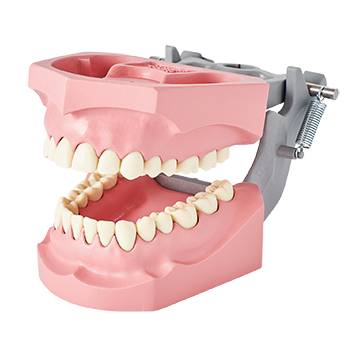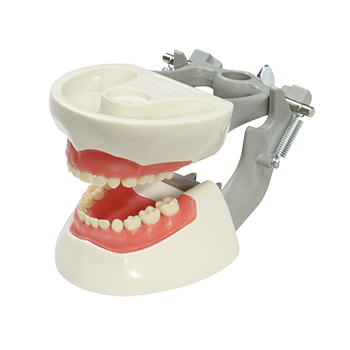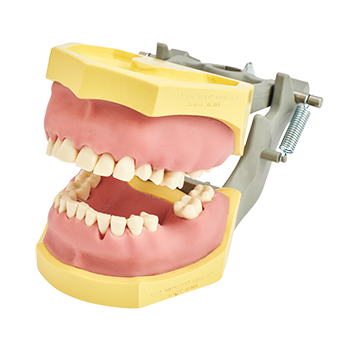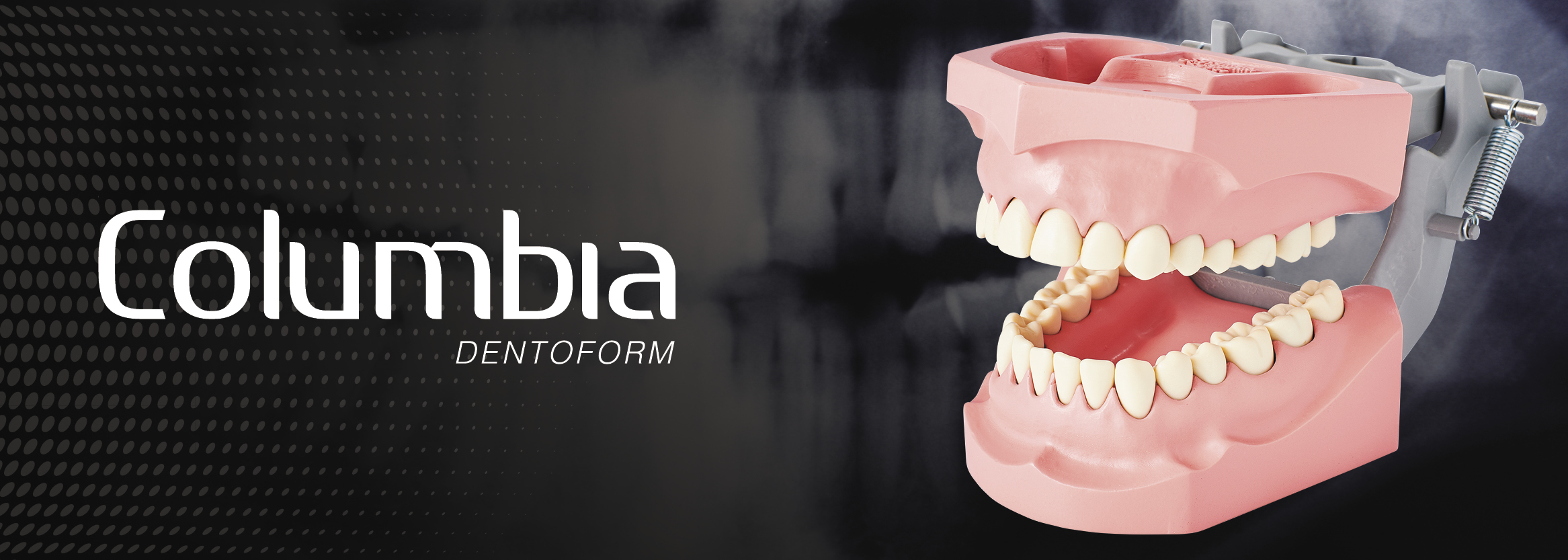Dental and dental hygiene students receive a few years of education and hands-on training with specialized tools before they are permitted work with live patients. One of these specialized tools is a dental typodont – a model that simulates a real patient’s oral cavity. Students generally acquire a typodont in their first year of dental school and will use it for at least their first two years, practicing skills such as probing, scaling, prepping and filling caries, or cavities.
There are different kinds of typodonts and typodont teeth that vary in construction and complexity, depending on what they are to be used for. Dental students in their third and fourth years will continue to practice on their original model with some modifications, as well as on more advanced models that simulate patients with complex dental cases such as bridges and implants. In this article, we will discuss typodonts in more detail, learn about Columbia Dentoform’s long history of innovation in designing dental typodont models and, finally, briefly outline different kinds of typodonts and their applications.
What is a Typodont
A dental typodont is a model of the structures that form the mouth and teeth, used to give dental and hygienist students hands-on practice both in the classroom and at home, as well as to educate patients about oral hygiene and treatment plans.
It is made of various types of plastic to simulate a real patient’s mouth, including the palate, gingiva, teeth, alveoli (tooth sockets) and, sometimes, the underlying alveolar bone. The gingiva is most often made of a rubber or silicone material, while the teeth are made of a harder material to simulate tooth enamel. The Columbia typodont uses Ivorine®, which grinds to dust like real teeth to prevent clogged handpieces.
Dental typodont models can be used alone or inserted into a dental manikin (described below).
Columbia Dentoforms
The words typodont, dentoform and dental model can be used interchangeably. In fact, typodont is now the accepted term for dental training models. Historically, the Columbia Dentoform typodont was produced by vacuum forming a mold over a plaster model of an actual patient impression—hence, the name dentoform. Today, modern typodonts generally are produced using digital technologies to make them as realistic as possible.
Columbia Dentoform was the first to introduce a dental typodont more than 100 years ago and has continued its legacy of innovation as a leader in dental curriculum building. Knowledgeable advisors partner with clients to customize models to suit their specific curriculum needs, providing unique solutions for all types of teaching institutions, including the specialty areas of orthodontic, endodontic, implant, periodontic, pediatric and even veterinary dentistry.
For example, a typodont was designed and created with a prosthodontics instructor in Houston that helped them to teach students four different skills that typically occur in succession in a number of patients with complex restorative cases:
- Basic orthodontia—moving or straightening one or a few teeth
- Implant placement in the open space
- Creation of a removable partial denture (RPD)
- Implant and final crown restoration
Columbia Dentoform Models
860 Series Adult Dentoform Typodonts
| The 860 Series typodonts, in particular the Columbia typodont SM-PVR-860, are Columbia Dentoform’s best-selling models. They provide students with a great level of detail, including a 30-degree condyle and an inclined Curve of Spee.
These models and replacement typodont teeth can be utilized for teaching restorative, fixed prosthodontics, orthodontic, endodontic, partially edentulous, anatomy and occlusion courses. They can be adapted to fit any bench manikin system and individual teeth are easily replaced for study or additional practice. |
 |
1560 Series Adult Dentoform Typodonts
| The 1560 Series typodonts allow for accurate interchangeability and stability, in addition to superior anatomy and occlusion.
These models and replacement typodont teeth can be utilized for teaching restorative, fixed prosthodontics, orthodontic, endodontic, partially edentulous, anatomy and occlusion courses. They can be adapted to fit any bench manikin system and individual teeth are easily replaced for study or additional practice. |
 |
Dental Hygiene Dentoform
| Dental Hygiene typodont comes standard with 32 removable numbered anatomical root teeth. Available with either clear or reddish translucent gums for instruction on subgingival instrumentation placement, adaption and alignment to the long axis of the tooth, providing excellent visual contrast with silver instrument blade adaptation for supra and subgingival scaling. Adjustable articulator keeps the typodont open both for instrumentation on manikin mount and for patient oral health instruction. Ideal for the demonstration of scaling and cleaning methods to both patients or students. |  |
Pediatric Dentoform
| Pediatric Dentoform typodonts are smaller in proportion than the adult models and come with 20 teeth, including six-year molars. The Mixed Dentition model comes with 24 teeth, simulating a 10-year-old child with both deciduous and adult teeth.
Columbia Dentoform pediatric typodonts remain popular with teaching institutions, as they are one of the few pediatric models available with everything accurately sized, with a child-sized manikin available as well. |
 |
Periodontal Dentoform
| Periodontal Dentoforms typodonts come with calculus on anatomically rooted teeth, while osseous and gingival defects simulate chronic generalized periodontitis. Teeth adhere with a simulated periodontal ligament (PDL) which simulates the feel and resistance of tooth extraction. This typodont features soft gums that are removable and replaceable. Also available with clear gums to view bone degeneration. |  |
Conclusion
Dental typodonts and typodont teeth offer an unparalleled instrument for dental and dental hygiene students to learn the necessary skills to practice dentistry before they work with real patients. They also provide a valuable visual aid for those same practitioners to educate patients on treatment plans and good oral hygiene. DENTALEZ’s Columbia Dentoform typodonts have led this space since they were invented more than 100 years ago; they will continue that innovation into the next century with game-changing teaching systems that keep pace with innovations in the dental industry. For questions about specific models or pricing, schedule a call with DENTALEZ.


